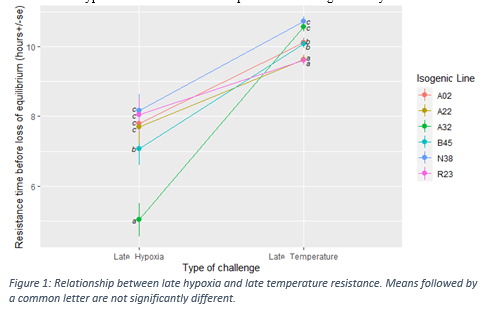RELATIONSHIP BETWEEN EARLY OR LATE RESISTANCE TO ACUTE TEMPERATURE OR HYPOXIA STRESSES IN SIX RAINBOW TROUT ISOGENIC LINES
Introduction
Rainbow trout (Oncorhynchus mykiss) is a fish that is particularly sensitive to changes in water quality. Global warming is expected to increase the frequency and intensity of heatwaves, resulting in more common combined acute hyperthermia and hypoxia conditions in fish farms (Reid et al., 2019). Such poor thermal and oxygenation conditions induce problems including growth losses, increased mortality and pathogens pressure. However, genetic selection to breed more robust fish is an interesting option to improve fish tolerance to non-optimal water quality (Vandeputte and Prunet, 2002).
Some research studies have already highlighted the potential of genetic selection for acute hypoxia and temperature resistance traits in fish (Chen et al., 2015; Ineno et al., 2005; Prchal et al., Unpublished data). In order to improve our understanding of the genetic architecture of these two traits, we used six isogenic rainbow trout lines. Within a line, all fish have the same genotype and preliminary tests revealed contrasting levels of resistance to hypoxia and temperature between lines. Using this research model, the objectives of the study were to: i) confirm the existence of genetic variability for resistance to hypoxia and high temperature; ii) investigate the ranking stability of genotypes at different ages for hyperthermia and hypoxia resistance traits, which is an essential information to determine the stage at which fish should be phenotyped in a breeding program; iii) determinate the relationship between hyperthermia resistance and hypoxia resistance.
Materials and methods
Six heterozygous rainbow trout isogenic lines were produced at the INRAE experimental fish farm (PEIMA, Sizun, France) by crossing one homozygous isogenic line providing eggs and six homozygous isogenic lines providing sperm. Each of the six lines were reared in separate tanks, in triplicates. Half of the fish of each triplicate were PIT-tagged at 16±9 grams and all lines were then pooled into the six tanks (~50 fish of each line in each tank) for the 6 early challenges (3 temperature and 3 hypoxia). The other half stayed in separate tanks for one more year and at 236±36 grams were PIT-tagged and mixed for the 6 late challenges (3 temperature and 3 hypoxia).
In hyperthermia challenge, temperature was gradually increased up to 27.5°C during 12 hours by adding heated water from a buffer tank. Oxygen concentration was maintained above 8mg/L. In hypoxia challenge, the level of oxygen was gradually reduced by bubbling nitrogen and reducing water renewal during 12 hours. In both challenges, fish were removed from the tank after loss of equilibrium and their PIT-tags and exact time were recorded. Fish were then individually weighted, anaesthetized and euthanized.
Resistance trait was analyzed as the time at loss of equilibrium of fish with the isogenic line as a fixed effect, the body weight as a covariate and the replicate as a random effect in a mixed linear model for each of the four challenges. When adequate, the resistance means of the different isogenic lines were compared using post-hoc Tukey tests with statistical significance set at 0.05. All analyses were completed with R software (V4.0.3).
Results and discussion
i) The fixed effect isogenic line was statistically significant in all challenges, confirming the effect of genetic variability on resistance to acute temperature or hypoxia stresses. Body weight effect was more complex with noticeable differences between early and late challenges. The interaction between isogenic line effect and body weight effect was significant in the two early challenges but not in the late challenges. Moreover, in hypoxia late challenge, body weight effect was significant while it was not in temperature late challenge. As a result, the resistance ranking of the genotypes was not stable in the early range of body weight (10 to 20 grams) because of the heterogeneity of slopes but stable in the late range of body weights (150 to 300 grams). It is therefore likely that the minimum phenotyping weight for resistance to acute temperature and hypoxia stress in rainbow trout falls between these two weight ranges.
ii) In the late challenges, i.e. once the ranking of genotypes was stabilized (with respect to weight), no clear rule appeared on the link between resistance to temperature stress and resistance to hypoxic stress (fig. 1). These results evidenced, at least partially, that resistance to hypoxia and resistance to temperature are two genetically different traits.
Acknowledgements
This study was supported by the European Maritime and Fisheries Fund and FranceAgrimer (Hypotemp project, n° P FEA470019FA1000016) and project CZ.02.2.69/0.0/0.0/18_053/0016975 - Development of the USB – International Mobilities II.
References
Chen, Z., Snow, M., Lawrence, C.S., Church, A.R., Narum, S.R., Devlin, R.H., Farrell, A.P., 2015. Selection for upper thermal tolerance in rainbow trout (Oncorhynchus mykiss Walbaum). J. Exp. Biol. 218, 803–812.
Ineno, T., Tsuchida, S., Kanda, M., Watabe, S., 2005. Thermal tolerance of a rainbow trout Oncorhynchus mykiss strain selected by high-temperature breeding. Fish. Sci. 71, 767–775.
Reid, G.K., Gurney-Smith, H.J., Flaherty, M., Garber, A.F., Forster, I., Brewer-Dalton, K., Knowler, D., Marcogliese, D.J., Chopin, T., Moccia, R.D., Smith, C.T., De Silva, S., 2019. Climate change and aquaculture: Considering adaptation potential. Aquac. Environ. Interact. 11, 603–624.
Vandeputte, M., Prunet, P., 2002. Genetics of adaptation in fish: Effects of domestication, stress resistance and adaptation to the environment. Prod. Anim. 15, 365–371.
